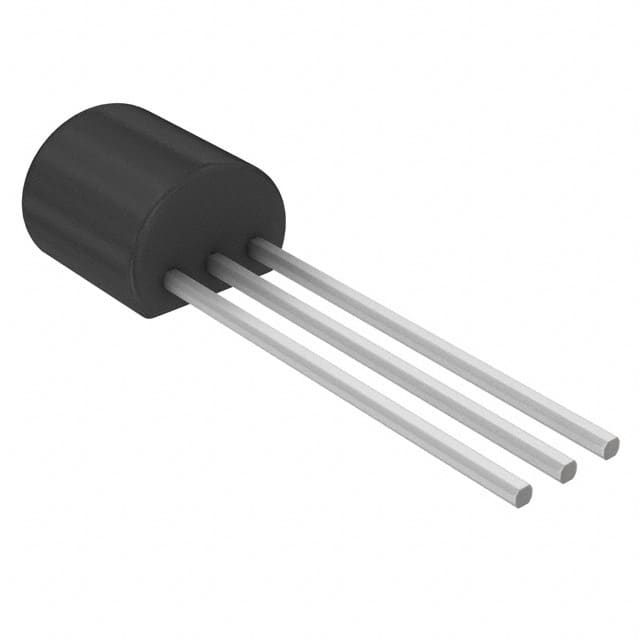Viz Specifikace pro podrobnosti o produktu.

J113-D74Z Product Overview
Introduction
The J113-D74Z is a versatile electronic component that belongs to the category of field-effect transistors (FETs). This entry provides a comprehensive overview of the product, including its basic information, specifications, pin configuration, functional features, advantages and disadvantages, working principles, application field plans, and alternative models.
Basic Information Overview
- Category: Field-Effect Transistor (FET)
- Use: Amplification, switching, and signal processing in electronic circuits
- Characteristics: High input impedance, low output impedance, voltage-controlled operation
- Package: TO-92 package
- Essence: Small-signal amplifier and switch
- Packaging/Quantity: Typically available in reels or tubes containing multiple units
Specifications
- Type: N-channel JFET (Junction Field-Effect Transistor)
- Maximum Drain-Source Voltage (VDS): 35V
- Maximum Gate-Source Voltage (VGS): -35V
- Maximum Continuous Drain Current (ID): 50mA
- Power Dissipation (PD): 350mW
- Operating Temperature Range: -55°C to 150°C
Detailed Pin Configuration
The J113-D74Z FET has three pins: 1. Gate (G): Controls the conductivity between the source and drain 2. Drain (D): Connects to the positive supply voltage 3. Source (S): Connects to the ground or common reference point
Functional Features
- High input impedance allows for minimal loading of preceding circuitry
- Low output impedance enables efficient signal transmission to subsequent circuit stages
- Voltage-controlled operation facilitates precise signal manipulation
Advantages and Disadvantages
Advantages
- High input impedance minimizes signal degradation
- Low output impedance ensures effective signal transmission
- Voltage-controlled operation offers precise control over signal processing
Disadvantages
- Susceptible to electrostatic discharge (ESD) damage
- Limited maximum voltage and current ratings compared to some other transistor types
Working Principles
The J113-D74Z operates based on the principle of field-effect modulation, where the conductivity between the source and drain is controlled by the voltage applied to the gate. When a voltage is applied to the gate, it creates an electric field that modulates the conductivity of the channel between the source and drain, allowing for amplification or switching of signals.
Detailed Application Field Plans
The J113-D74Z finds applications in various electronic circuits, including: - Audio amplifiers - Signal processing circuits - Switching circuits - Oscillator circuits - Sensor interfaces
Detailed and Complete Alternative Models
Some alternative models to the J113-D74Z include: - 2N5457 - J201 - MPF102 - BF245
In conclusion, the J113-D74Z is a valuable component in electronic circuit design, offering high input impedance, low output impedance, and voltage-controlled operation. Its applications span across audio amplification, signal processing, and switching circuits, among others.
Word count: 443
Seznam 10 běžných otázek a odpovědí souvisejících s aplikací J113-D74Z v technických řešeních
What is the J113-D74Z component used for in technical solutions?
- The J113-D74Z is a JFET (junction field-effect transistor) commonly used for signal amplification and switching applications in electronic circuits.
What are the key specifications of the J113-D74Z?
- The J113-D74Z typically has a low input capacitance, high transconductance, and low noise characteristics, making it suitable for high-frequency and low-noise applications.
How does the J113-D74Z compare to other JFETs in terms of performance?
- The J113-D74Z offers competitive performance in terms of low noise, high gain, and low input capacitance compared to other JFETs, making it a popular choice for various technical solutions.
Can the J113-D74Z be used in audio amplifier circuits?
- Yes, the J113-D74Z is often used in audio amplifier circuits due to its low noise and high gain characteristics, which are beneficial for maintaining signal fidelity.
What are the typical operating conditions for the J113-D74Z?
- The J113-D74Z is designed to operate within a specific range of voltage and current, typically around 25V and a few milliamperes, but it's important to refer to the datasheet for precise specifications.
Are there any common applications where the J113-D74Z is not recommended?
- While the J113-D74Z is versatile, it may not be ideal for high-power applications or situations requiring extremely high input impedance, so it's important to consider these factors when selecting components.
What are the potential drawbacks or limitations of using the J113-D74Z?
- One potential limitation is its relatively limited voltage handling capability compared to some other transistors, so it may not be suitable for high-voltage applications without additional circuitry.
Can the J113-D74Z be used in low-power sensor interfaces?
- Yes, the J113-D74Z can be well-suited for low-power sensor interfaces due to its low noise and high input impedance, which can help preserve weak sensor signals.
Is the J113-D74Z readily available from multiple suppliers?
- The availability of the J113-D74Z may vary depending on the region and supplier, so it's advisable to check with multiple distributors to ensure availability.
Are there any known best practices for incorporating the J113-D74Z into technical solutions?
- Best practices include proper biasing, attention to thermal considerations, and ensuring that the J113-D74Z operates within its specified parameters to achieve optimal performance and reliability.

